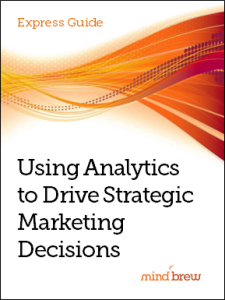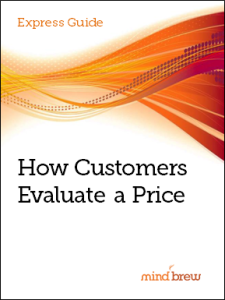How are you currently using your marketing analytics tools?
If you are like most B2B marketers, you are probably tracking clicks, traffic and views so that you can see which of your campaigns worked and which didn’t. If you’re a very good marketer, you may also be tying your metrics to revenues and margins so that you can determine the return on investment (ROI) for your efforts. That, in turn, shows you which programs were worthwhile and which weren’t.
Using your analytics tools in these ways is very necessary, and we applaud you for it.
But you could be using your analytics to do so much more.
Typically, B2B marketers are using their metrics to learn things about the past. But what if you could use your analytics to help you make decisions about the future?
And often B2B marketers are using their analytics to guide their tactics. But what if you could use your analytics to help you think more strategically.
Your marketing and sales data is an excellent source of information about the effectiveness of your marketing and sales efforts—and it can also be an excellent source of data for guiding your company’s efforts as a whole. If you approach your analytics from a more strategic perspective, you can find answers to some very important questions that could help your company become more competitive and more profitable.
We recommend that B2B marketers use their analytics tools to answer five key strategic questions:
- Where can we make more money? Use your analytics to identify which products, markets and customers have been the most profitable for your firm in the past. More importantly, determine which are currently growing. If you have trend lines pointing up and to the right for certain combinations of products and customers, that’s where you should focus more efforts in the future.
- Which customers should we target? This is a question where examining margin data can be especially helpful. You don’t just want to target the customers who buy the most from your company, you want to target the customers that are the most profitable for your company. Find out where you are getting the biggest return for the least amount of investment, both in terms of dollars and human resources, and go after more of those customers.
- Where do we have an advantage? Take a look at your sales wins. Are customers beginning to switch from a competing offering to one or more of your products? If possible, tease out the reasons for that switch and use those reasons to guide your sales and marketing efforts. If you can spot a trend early, you’ll have the opportunity to exploit a market advantage to your benefit. Don’t be afraid to explicitly mention these advantages in your advertising and sales materials—it will make them much more effective.
- Where can more growth come from? Which customers could be buying more of your products? In which markets do you have an advantage that you haven’t fully tapped? Which customer groups are growing? Again, dig into your analytics tools and look for emerging trends.
- What products/offerings should we focus on? Too often, B2B marketers forget that one of the “4 Ps” is product. Use your marketing metrics and margin data to identify which products are the most profitable for your company, and then focus your advertising and marketing efforts on those items.
In the end, it really comes down to identifying what is working well for your company and doing more of that. Becoming a more strategic marketer is a long-term process, but it can pay huge dividends. To learn more about using your analytics tools to guide future strategy, read the express guide Using Analytics to Drive Strategic Marketing Decisions.







